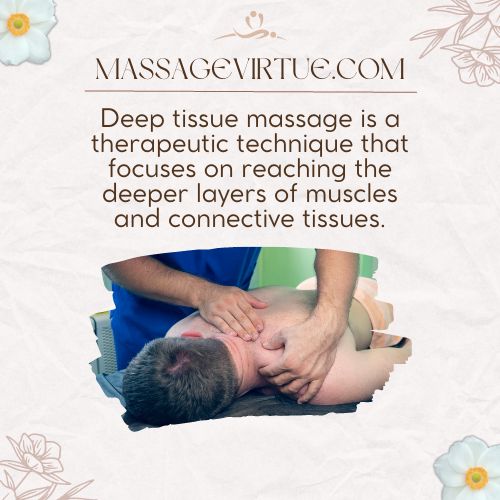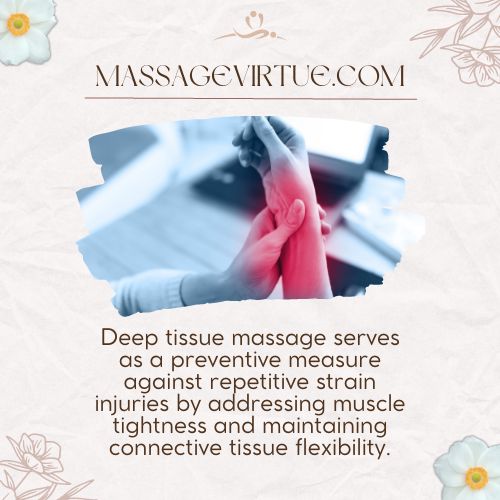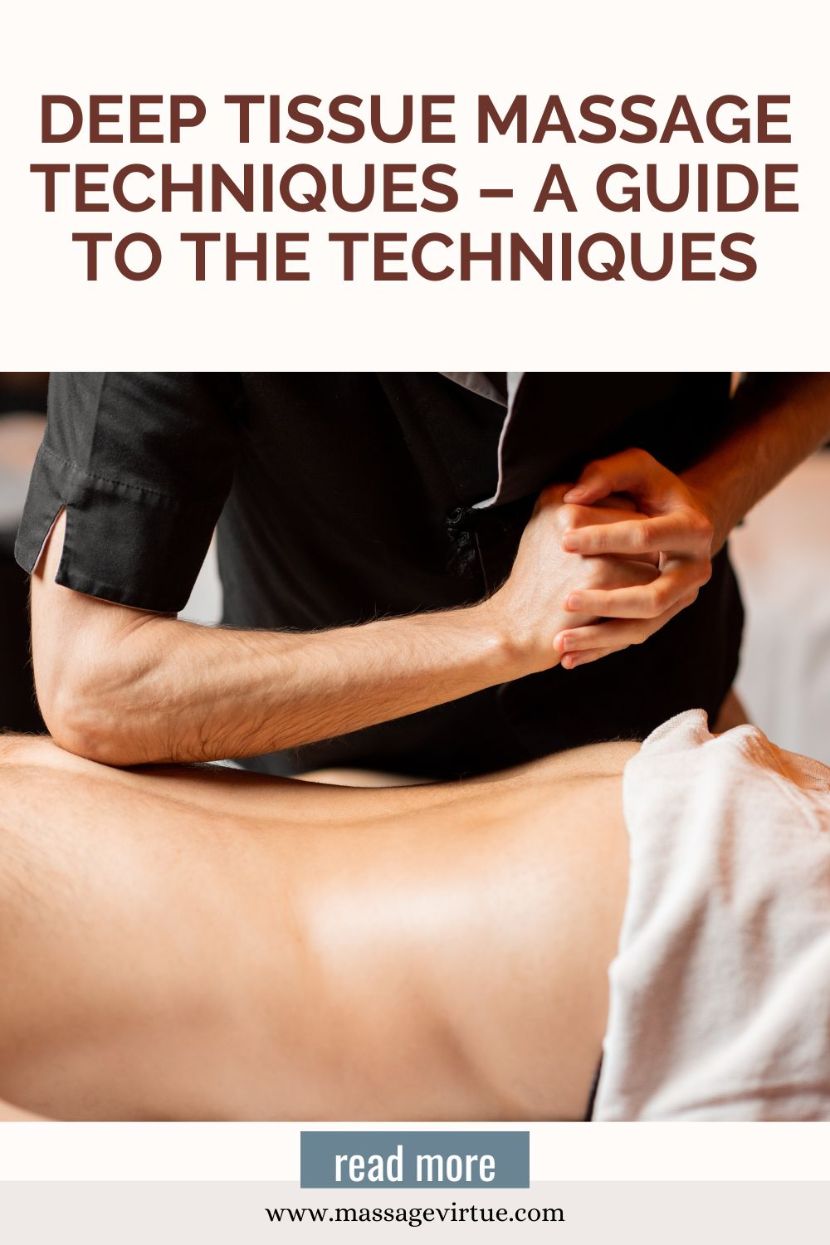If you’ve ever wondered about the magic behind those firm, targeted strokes that melt away muscle tension, you’re in the right place.
In this article, we’ll dive deep into the world of deep tissue massage, exploring the techniques, benefits, and even the potential risks.
Whether you’re a massage therapist, an athlete, or someone dealing with chronic pain, this guide is tailored just for you.
What is a Deep Tissue Massage?
Before we dive into the nitty-gritty details of deep tissue massage techniques, let’s understand what it is in simple terms.

Deep tissue massage is a specialized form of massage therapy that focuses on releasing tension and tightness in muscles and connective tissues. Unlike a gentle Swedish massage, deep tissue massage goes beyond the surface.
It targets those deep-seated knots and muscular issues.
Deep Tissue Massage Techniques
Now, let’s get down to the core of our topic – deep tissue massage techniques. These are the hands-on methods used by massage therapists to work their magic and provide relief to clients. Here, we’ll explore the following techniques:
1. Myofascial Release
Myofascial release is a crucial facet of deep tissue massage.
Fascia, a thin web-like tissue surrounding muscles and organs, can become tight and restrictive over time.
This technique involves gentle, sustained pressure to relax and release tension in these fascial areas, providing relief from discomfort and enhancing mobility.
2. Trigger Point Therapy
Trigger point therapy addresses tight knots within muscles that can radiate pain to other areas of your body.
By applying precise pressure to these trigger points, therapists can effectively relieve pain and restore normal muscle function. Think of it as a skilled therapist using their fingertips to coax those knots into relaxation.
This ultimately provides you with relief and renewed muscular harmony.
3. Muscle Tension Release
Deep tissue massage is your solution for stubborn muscle tension.
Therapists use their knuckles, elbows, or forearms to apply deep, focused pressure to areas where tension resides.

This pressure encourages tight muscles to relax, improves blood flow, and gradually dissipates the unwelcome tension. It’s like a skilled sculptor chiseling away at the tension, leaving you feeling relaxed and rejuvenated.
4. Muscle Soreness Relief
Deep tissue massage is a boon for athletes and those with muscle soreness.
By breaking down adhesions and reducing inflammation, it speeds up the recovery process and offers relief from sore muscles. This technique improves circulation, delivering essential nutrients to muscles while carrying away waste products.
Whether you’ve completed a marathon or an intense workout, deep tissue massage can expedite your recovery.
5. Repetitive Strain Injury Prevention
Deep tissue massage serves as a preventive measure against repetitive strain injuries by addressing muscle tightness and maintaining connective tissue flexibility.
It keeps muscles supple and flexible.

This technique reduces the risk of injuries stemming from repetitive motions at work or during sports activities. Think of it as a protective shield for your body, ensuring it remains resilient to the wear and tear of repetitive actions.
Deep Tissue Massage Techniques For Legs
When it comes to deep tissue massage for the legs, specific techniques can provide much-needed relief for athletes and those with muscle tightness. Here are some targeted approaches:
1. Quadriceps Release: Focuses on the front thigh muscles to alleviate tightness often experienced by runners and cyclists.
2. Hamstring Relief: Targets the muscles at the back of the thigh, ideal for individuals with hamstring issues or sciatica.
3. Calf Soothing: Helps relieve calf muscle tightness, which is common in athletes and those with foot or ankle issues.
4. IT Band Release: Addresses the iliotibial (IT) band, a common source of knee and hip pain in athletes.
5. Shin Splint Relief: Techniques for the shin muscles can be beneficial for athletes dealing with shin splints or chronic pain.
Deep Tissue Massage – Benefits Vs. Dangers
Let’s weigh the pros and cons of deep tissue massage. To make it easier to digest, here’s a handy table that breaks down the benefits and potential risks:
| Benefits | Dangers |
| Relieves chronic pain | Soreness and discomfort during or after the massage |
| Improves mobility | Bruising in sensitive individuals |
| Reduces muscle tension | Potential for aggravating acute injuries |
| Enhances flexibility | Risk of post-massage fatigue |
| Promotes stress relief | Temporary muscle soreness |
Are Deep Tissue Massages Good For You?
Deep tissue massages can be highly beneficial when performed by a skilled therapist.
However, it’s essential to consider your specific needs and medical history. If you’re unsure whether deep tissue massage is right for you, consult with a qualified massage therapist or healthcare professional.
They can help you determine the best approach to address your concerns.
Conclusion
Deep tissue massage techniques are a valuable tool for addressing muscle issues, chronic pain, and stress relief.
Whether you’re seeking the expertise of a professional massage therapist or exploring self-massage, understanding these techniques empowers you to take control of your well-being.
Remember to consult with a healthcare professional if you have specific health concerns, and enjoy the benefits of deep tissue massage responsibly.
FAQs
What Makes a Good Deep Tissue Massage?
A Good deep-tissue massage is one that effectively addresses your muscle tension and discomfort. It should be firm and focused, targeting the areas of your body where you feel tightness or pain.
The massage therapist should use proper techniques to release tension in your muscles and help you feel more relaxed and flexible afterward.
What Is the Difference Between Massage Therapy and Deep Tissue Massage?
Massage therapy encompasses many techniques and styles, while Deep Tissue Massage is a specific type of massage that aims to work on the deeper layers of your muscles and connective tissues.
So, deep tissue massage is a part of massage therapy but with a particular focus on deep muscle issues.
What Are the 6 Massage Techniques?
The six common Massage Techniques include:
- Effleurage
- Petrissage
- Tapotement
- Friction
- Vibration
- Compression
What Is the Most Effective Massage Technique?
Deep tissue massage is often considered effective for relieving deep muscle tension.
However, what works best for you can depend on factors like your pain, stress levels, and personal preferences. It’s essential to discuss your goals with your massage therapist to determine the most suitable technique for you.
What Type of Massage Do Chiropractors Use?
Chiropractors typically use a form of massage known as Chiropractic Massage or Manual Therapy as part of their treatments.
This type of massage focuses on adjusting joints and manipulating soft tissues to address musculoskeletal issues. Chiropractors use various massage techniques to complement their spinal adjustments and promote overall wellness in their patients.


